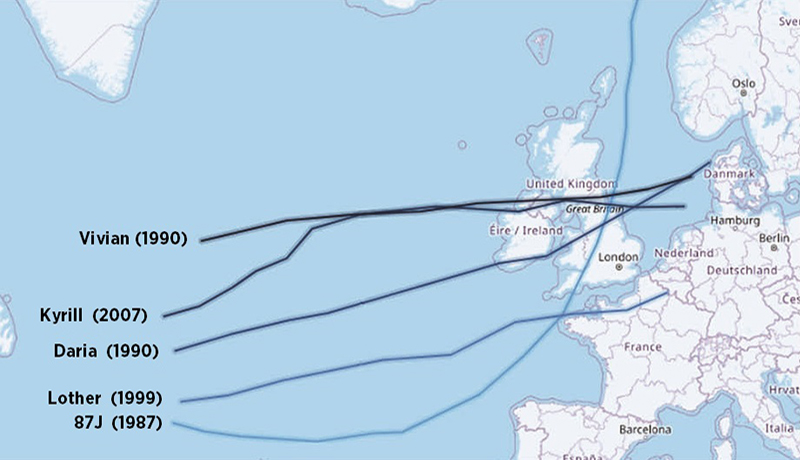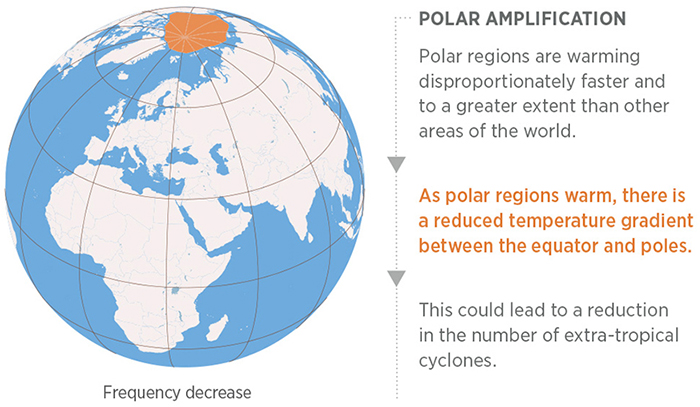The physical basis
To help answer those questions, we need to first reflect on the physical mechanisms that lead to these events—as it is only by understanding this that we can answer questions of frequency and intensity changes under climate change.
There are multiple different processes over the North-Atlantic responsible for the final strength of a cyclone or its respective damage-prone wind field. Those processes act on different timescales, from days (so called synoptic scale) to decades, or even longer—which is particularly the case with slow-varying conditions or a changed climate due to increases in greenhouse gas concentrations. It also makes sense to separate the distinct processes that cause cyclone formation in contrast to those forces that drive intensification and those that steer these storms towards different European land-areas. Of course, it’s vital to keep in mind that a coupling may exist between some factors that could lead to systematic increases in both formation and intensity.
Formation
The formation of Extratropical cyclones, unlike tropical cyclones, starts in the mid- to upper troposphere as the westerly flow (specifically, the upper-troposphere jet stream) becomes unstable. This leads to the formation of waves of different wavelengths and depending on the overall temperature and pressure gradients between the northern and southern side, conditions may become imbalanced. This so-called baroclinic instability leads air in the upper troposphere to diverge (spread out). As a consequence, surface pressure drops, air rises from the surface to compensate, leaving surface air to flow into the low-pressure region, resulting in an extra-tropical cyclone being formed.
Intensification and Steering
Because the strength of the poleward temperature gradient controls the strength of the jet stream, it is a decisive factor in ETC formation. Conditions near the surface in the lower troposphere may also influence the temperature gradient towards the pole. If there is enough baroclinic instability, conditions are very suitable for these storms to intensify and become more severe (particularly in terms of their windspeed).
This available baroclinicity may also depend on larger-scale factors that operate on different time scales such as the phases of the North Atlantic Oscillation (NAO) or slow varying sea surface temperature changes. Evaporated water within a cyclone is also crucial to intensification, as the release of so-called latent heat from cloud formation (i.e., condensation) fuels the cyclone further.
Where these storms make landfall across Europe is then driven by larger scale pressure patterns over the North Atlantic and throughout the troposphere. These patterns (such as the East-Atlantic Pattern or Scandinavian) can act to block or channel storms to different latitudes of Europe.
Recent Climatological Variability and Future Climate Change
The late 1960s to 1990s saw a significant and substantial increase in European storm frequency leading to an increase in research about the NAO. At the time, and partly still today, the question is posed as to how far anthropogenic activity could be responsible for longer-term increases in storm frequency—particularly given that in recent years a hiatus phase has been more dominant. All of which brings in the importance of understanding longer-term decadal variability alongside the anthropogenic changes to the climate.

Figure 2 – Polar amplification – disproportionate warming of the polar regions due to climate change.
Future Frequency
It’s been observed that the polar regions are heating up faster than the extra-tropics and tropics (a process called polar amplification).
This heating has the consequence of reducing the necessity for the poleward transfer of energy by ETCs and thus leads to a decrease in the overall temperature gradient. The logical consequence of this could be fewer cyclones overall, a finding which is supported by model studies.
Changes in Severity
However, the picture gets more complex when we start to consider storm severity. Model studies for the future suggest that increased greenhouse gas concentrations lead to an increase in the overall temperature gradient in the upper troposphere—the exact region where baroclinic waves grow best. All of which leads to the potential for more intense European windstorms in the future. Model studies confirm this process along with the possibility of having more explosive cyclone development and deepening. Thus, it is understandable why the latest IPCC report can’t conclusively answer the question of future anthropogenic influences on European windstorms given it will depend on this ‘tug of war’ between two competing factors.
However, given that it is only the most severe European windstorms that are the most dangerous and costly from an insurance perspective, increased intensity could be a more telling factor in determining future risk than a total overall reduction in the number of cyclones.
What is clear though is the pressing need for a deeper understanding of how these different factors interact. While significant progress in the ability to predict severe windstorms over Europe was made in the latest seasonal forecast model suites, the sub-decadal to decadal timescale and beyond needs further active research. Ideally, this is best informed by collaborations between science and industry to fully tackle these real-world applications.
Gregor Leckebusch is Professor of Meteorology and Climatology at the University of Birmingham and is a UK Met Office Joint Chair.






